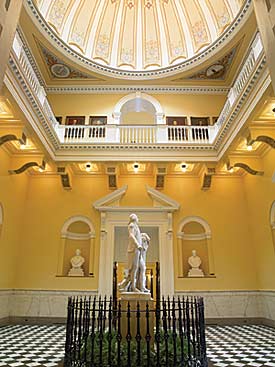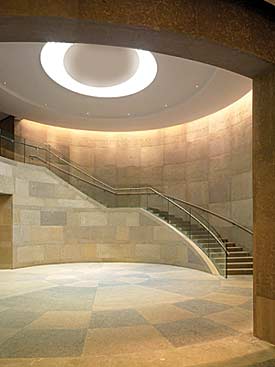A Revered Jeffersonian Landmark Renewed
The finishing touch
Designers easily decided that the visitor center itself should be contemporary in style to clearly distinguish it from the historic building, as is the preference in preservation circles. But determining the style of the new entrance at the bottom of the hill was not as clear cut: Should it reflect the Modern extension or the Classical original?
|
||||
At the suggestion of Loth, the architect decided to use the Bremo Estate, near Staunton, Virginia, as a model. There, situated on a hill, is a Palladian-style house, designed and constructed around 1820 by one of Jefferson's skilled builders. A miniature Classical monument, known as Temperance Temple, designed by noted architect Alexander Jackson Davis, was built on the grounds of the estate in 1841, but at a lower elevation than that of the house.
The logic was compelling. As Skarmeas explains, most of the buildings that surround Richmond's Capitol Square are Classical in expression, so a pure Modernist entry would seem out of place. Bremo's diminutive temple was modeled after a prototype in Athens-home of the Parthenon, the first temple on a hill. And it stands in relation to its Jeffersonian-styled house much in the same way that the new public entry should stand in deference to the capitol. The temple at Bremo "had the proper pedigree, going all the way to Athens, without copying a Thomas Jefferson building," says Loth.
|
||
Set at an angle to the street grid to create a small irregularly shaped plaza, the complex's new public entry features Doric instead of the capitol's Ionic columns, a simplified entablature without a pediment, and a pale yellow hue. It clearly welcomes visitors and prepares them for their journey, but in no way competes with their ultimate destination.











